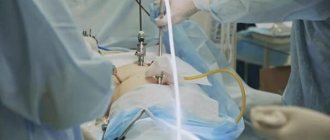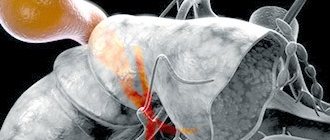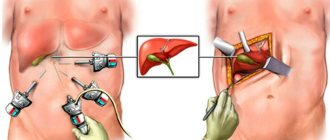Removal of the gallbladder is a common type of surgery; it is prescribed in the presence of stones and severe pathologies that interfere with the normal functioning of the organ. The operation is carried out using an open or gentle endoscopic method, subject to the doctor’s recommendations, the recovery period is quick, without any particular complications.
Indications and contraindications for cholecystectomy
Cholecystectomy is the surgical removal of the gallbladder; it is performed for various forms of cholecystitis and the development of atrophic processes in the organ. The main reasons for the development of pathologies are errors in nutrition, sedentary lifestyle, helminthic infestations, hormonal imbalance, gastrointestinal diseases, obesity.
When surgery is required:
- blockage of bile ducts and excretory tracts with stones;
- cholecystitis in the acute stage;
- cholelithiasis;
- severe dysfunction, rupture of the gallbladder;
- the presence of polyps on the mucous membrane of the organ.
Important! Most doctors recommend resection if the size of the stones exceeds 2 cm; conservative treatment methods do not improve a person’s well-being.
Contraindications
Cholecystectomy is a necessary surgical intervention that helps to avoid the development of severe complications, but in some cases it cannot be performed.
Main contraindications:
- cholelithiasis without obvious signs in elderly patients;
- serious problems with the respiratory system, heart, kidneys;
- III trimester of pregnancy;
- peritonitis;
- adhesions in the organs of the digestive tract, the presence of malignant neoplasms in the body;
- cirrhosis, pancreatitis in the acute stage;
- problems with blood clotting.
The operation is not performed if the attack of acute cholecystitis lasts more than 72 hours; first, the main symptoms are relieved, then the affected organ is removed.
Reviews
Alina: “I decided to have laparoscopy after talking with the doctor. The operation went quickly and without consequences. Despite the fact that according to the policy it is done free of charge, I wanted to thank the doctor for the high quality of his work and professionalism.”
Lydia: “The procedure was required due to a large number of gallstones. The specialist recommended complete removal of the organ to prevent subsequent relapses. It’s been 3 years now, but nothing bothers me.”
Irina: “Judging by the reviews, laparoscopy is safe and really gets rid of gallstone problems. I wanted to do the procedure for a fee, however, the price varied so much that I could not choose a clinic. As a result, I took advantage of the policy and went to the gastroenterology department. I am now quite satisfied with the quality of services received and my state of health.”
Arthur: “The operation lasts no more than an hour. However, during this time you can get rid of a problem that has been bothering you for years. I recommend laparoscopy as a reliable method of dealing with gallstones.”
Preparing for gallbladder removal
Before surgery, the patient needs to undergo a comprehensive examination, examination by a cardiologist or therapist.
Preoperative diagnostic methods:
- clinical, biochemical blood test;
- tests for viral hepatitis, HIV, sexually transmitted diseases;
- coagulogram;
- esophagogastroduodenoscopy;
- Ultrasound of the gastrointestinal tract;
- cholecystography;
- electrocardiogram, comprehensive study of the lungs and heart;
- MRI, CT;
- colonoscopy, fistulography according to indications.
Diagnostics are carried out to determine the severity of pathologies, assess the size, structure, functions of the gallbladder, identify stones, adhesions, and neoplasms.
A week before surgery, you must stop taking medications that affect blood clotting, NSAIDs, and vitamin E. For 3–4 days before laparoscopy, you should not eat fruits, cabbage, legumes, or bread. On the eve of the operation, dinner should be light, no later than 18–19 hours; in the morning you should not drink or eat anything.
Immediately before the operation, the patient is given laxatives, Espumisan, and given a cleansing enema.
How is the operation performed?
Removal of the gallbladder is carried out in two ways - laparoscopy and open cholecystectomy. For any type of operation, general endotracheal anesthesia is used; in the presence of bronchial asthma, anesthesia is administered intravenously. The difference between scars after various interventions can be seen in the photo.
The average duration of laparotomy is 1–2 hours, abdominal surgery lasts 3–4 hours, but if during the intervention there is a need to remove stones from the ducts, the duration of cholecystectomy increases.
Laparoscopic method
A popular and safe method of surgical intervention, during which no incisions are made, which reduces the risk of negative consequences. After laparoscopy, no noticeable scars remain, the pain syndrome is mild, and the patient is discharged after 3–5 days.
Stages of laparoscopy:
- 4 small punctures are made in the abdominal cavity, gas is injected to expand the operating area and provide better visual control of the actions.
- A video camera and surgical instruments are inserted into the punctures.
- Clips are attached to the bile ducts and arteries.
- The gallbladder is removed, bile is removed from the ducts, and the tissue is cauterized.
- Instead of a removed organ, drainage is installed to drain excess fluid from the cavity.
- Stitches are placed on the punctures.
A new method of resection is the NOTES technology - the operation is performed without incisions, the endoscope is inserted through the mouth or vagina. But this technique is rarely used; it is undergoing clinical testing.
Important! The recovery period after laparoscopy lasts only 2–3 weeks, after abdominal surgery – 1.5–2 months.
Cavitary cholecystectomy
Such a surgical intervention is carried out in case of severe inflammation of the gallbladder, an acute form of the pathology, in the presence of large stones, if there are contraindications for laparoscopy.
Progress of the operation:
- After administering anesthesia, a midline or oblique incision is made under the ribs with a scalpel.
- The organs adjacent to the gallbladder are displaced, blocking the artery and ducts.
- The gallbladder is removed and the surgical area is examined.
- The incision is sutured.
After the operation, the patient remains in the hospital for 1.5–2 weeks. It is necessary to take strong painkillers for several days.
Abdominal surgery is also performed from a mini-access - the incision size is no more than 7 cm, it is made in the area of the right hypochondrium, intervention is used in the presence of adhesions, the presence of an inflammatory infiltrate. The time to remove the affected organ is approximately 1.5 hours.
Preparatory drug therapy
If necessary, to prevent complications, as well as improve the functional state of the structures of the hepatobiliary system, the doctor may prescribe preparatory drug conservative therapy, which usually lasts several days. Such treatment may include antibacterial agents of various groups, antispasmodics, choleretics or cholekinetics, which improve the process of formation and outflow of bile from the structures of the hepatobiliary system. The doctor determines the duration of such preparatory treatment, the type of medications, and their dosage individually, which depends on the severity of the inflammatory process, as well as the individual characteristics of the patient.
Proper preparation before removal of the gallbladder is the key to successful completion of the operation, as well as reducing the duration of the postoperative period.
Life after surgery
The recovery period begins after the patient is transferred to the recovery room - within an hour the person recovers from anesthesia, nausea, dizziness, pain often occur, and after laparoscopy the person feels very chilly.
After 6 hours, you need to start getting up slowly to avoid the appearance of stagnation, speed up the recovery process, at first there is weakness, trembling in the limbs, dizziness, every day the duration and intensity of physical activity should be increased.
The drainage is removed after a day, the wounds are sealed with adhesive tape, after 2 days you can take a shower, but you absolutely cannot rub the stitches. Wounds are regularly treated with antiseptic solutions, stitches are removed after 8–10 days, the procedure is almost painless.
For 3 months you cannot visit saunas, steam baths, solariums, or lift weights of more than 2 kg; you can return to intense training in a month if there are no complications.
Often after abdominal surgery, patients are recommended to wear a special support bandage for 3 weeks.
Medicines after surgery
No special drug therapy is required during the postoperative period; in case of severe pain, NSAIDs and antispasmodics are prescribed - Nurofen, Nise, Papaverine, No-shpa. To improve and restore the digestion process, you should take enzymes - Creon, Pancreatin.
Cholecystectomy is an indication for sanatorium-resort treatment - taking mineral waters, radon, pine baths, electrophoresis with succinic acid.
Nutrition
Within 24 hours after surgery, a person is contraindicated in eating; they can drink small amounts of still water. For 3–5 days, the diet consists of light foods - soups with vegetable broth, oatmeal, kefir, pureed vegetables.
Gradually, cottage cheese, yogurt, lean meats and fish, seafood, buckwheat porridge, bananas and other fruits, and vegetable fats are being introduced into the menu. You need to eat often, in small portions, and avoid long breaks between meals.
After removal of the gallbladder, it is strictly forbidden to drink strong tea and coffee, alcoholic beverages, fatty, spicy, smoked, fried foods, and sweets - these rules will have to be followed for at least 2 years.
In short courses you need to drink sulfate and chloride-sulfate mineral waters, decoctions of herbs with a choleretic effect - milk thistle, immortelle, artichoke.
→ More about diet after gallbladder removal
After cholecystectomy, a sick leave certificate is issued for 10 days; if complications are observed, it can be extended by 4 weeks. If the patient does not have time to recover during this time, a medical commission is assembled, which can increase the period of temporary incapacity to 1 year, but in this case the person must visit the doctor once every 15 days, as soon as his health improves, he will be discharged immediately.
Possible consequences and complications
Most often, complications in the form of intestinal paresis, hernia, and respiratory dysfunction are observed after abdominal surgery.
Why is the operation dangerous?
- infectious processes, wound suppuration;
- internal bleeding;
- formation of stones in the ducts, blood clots in the vessels;
- damage to the bile ducts.
Important! If the stones are not removed in a timely manner, calcification of the walls and gallbladder carcinoma develop; when the organ is perforated, bile acids penetrate into the abdominal cavity, which can lead to the development of an abscess and fistulas.
Contact litholysis
This is an operation to remove stones with complete preservation of the organ. When the underlying disease is cured, it has a very good prognosis. In Russia, the technique is under development, most of the operations are carried out abroad.
It includes several stages:
- Application of a microcholecystotomy. This is a drainage tube through which the contents of the gallbladder are removed.
- Assessment by injection of a contrast agent of the number and size of stones, which allows you to calculate the exact amount of litholytic (solvent) and avoid its entry into the intestine.
- Introduction of methyl tert-butyl ether into the cavity of the gallbladder. This substance effectively dissolves all deposits, but can be dangerous for the mucous membranes of neighboring organs.
- Evacuation through a bile drainage tube with litholytic.
- Introduction of anti-inflammatory drugs into the cavity of the gallbladder to restore the mucous membrane of its walls.








